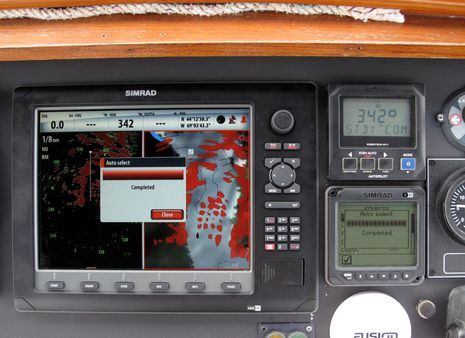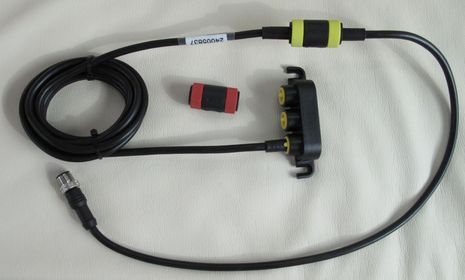SimNet network testing, & more NSE goodies
Years ago I gave Simrad grief for developing its own NMEA 2000 cable and connector system, called SimNet, instead of going with the DeviceNet standard as NMEA wanted. When NMEA 2000 was just getting started, SimNet confused end users and instal...
Years ago I gave Simrad grief for developing its own NMEA 2000 cable and connector system, called SimNet, instead of going with the DeviceNet standard as NMEA wanted. When NMEA 2000 was just getting started, SimNet confused end users and installers alike, as would Raymarine's SeaTalkNG, and Lowrance's first version of LowranceNet, etc. I remain leery about proprietary cabling but I've never heard of performance issues with SimNet, and I've never had any trouble integrating SimNet devices into standard N2K networks, using male versions of the adapter cable seen above. Until this week, however, I'd never tried it the other way around, building a SimNet network and adding in other manufacturer's N2K devices as desired. No problems so far...
The thin cables certainly are easy to snake around a boat and the connectors aren't even threaded (though they plug together with reassuring snugness). I was also pleased to learn that Simrad has those inline connectors seen above (red with termination built in, yellow without), which nicely increase lay out possibilities. There's no such thing as SimNet field attachable connectors, mind you, and the cable really isn't designed to be cut (as you can see here), but that's not a bad limitation if you can run pre-made cables wherever you need them. And if you check out the manual available at Simrad's SimNet page, you'll see that the rules about daisy chaining and even termination are pretty loose. I know such looseness vexes NMEA, and I understand their desire to protect the standard, but has anyone heard of a SimNet install that failed to network data and power successfully?If there have been SimNet failures, and we might hear about them in comments, I'll bet they involve extra large networks in which the nuances of N2K -- like voltage drops and impedance distortiions -- can get critical. As you can see below on the NSE12 device list, Gizmo's SimNet is pretty simple so far, but I intend to challenge it in the months ahead. Simrad is suppossedly going to let me try a AP28 autopilot system, whose head unit, compass, rudder sensor, and processor are all SimNet. Plus I've set up Gizmo so I can fairly easily replumb any device from the standard N2K backbone to SimNet, as I did below with the Garmin AIS600 and Maretron DST100.
There are reasons why even a vessel with a lot of Simrad equipment might choose to go with standard NMEA 2000 cabling. If Simrad's SimNet parts inventory is low, as seems to be the case these days, there are no alternatives. And if a boat's network grows to extra large size, I suspect that NMEA 2000 certified cable and connectors -- especially split power taps and MID size cable -- are going to serve better. The cost of SimNet pieces seems a little mysterious, too, as indicated on this West Marine page, which shows three different prices for the same seven pin multiport, ranging from terrific deal to nearly outrageous! Personally, I might try to, say, use a 10m section of SimNet cable in an otherwise standard backbone because it made fishing the mast much easier, but I'd treat it as experimental (in fact, I will experiment with that). Of course the main reason someone would choose SimNet is because they are going with an all (or mainly) Simrad system, which is becoming a compelling choice...
 One pleasant surprise I got when I fired up the Simrad gear on Gizmo's rebuilt flying bridge dash was how the IS20 and NSE12 share data source configuration. When I put the former into auto select mode, the latter came along for the ride (as you can see below), and changing a specific source (when I added in another heading device) on one unit changed it everywhere. I think that you can bypass common sourcing, if desired, using SimNet "groups" but haven't tried that yet. (I also think that this integration would work fine over standard N2K cabling, because the devices can't tell the difference, but, interestingly, that is not necessarily true of Raymarine SeaTalkNG, which contains a sixth wire that Ray devices can apparently use to determine cable type.)
One pleasant surprise I got when I fired up the Simrad gear on Gizmo's rebuilt flying bridge dash was how the IS20 and NSE12 share data source configuration. When I put the former into auto select mode, the latter came along for the ride (as you can see below), and changing a specific source (when I added in another heading device) on one unit changed it everywhere. I think that you can bypass common sourcing, if desired, using SimNet "groups" but haven't tried that yet. (I also think that this integration would work fine over standard N2K cabling, because the devices can't tell the difference, but, interestingly, that is not necessarily true of Raymarine SeaTalkNG, which contains a sixth wire that Ray devices can apparently use to determine cable type.)Of course, the more important stuff is beyond the small data networking, assuming that works OK, and I'm sure liking what I've seen so far in NSE software 2.0, like the Insight chart improvements already discussed, plus the enhancements the BR24 Broadband Radar got with an easy-to-do update. (You can download an interesting Simrad PDF about all 2.0 improvements here.) I haven't tried BR True Motion yet, but the 36 rpm mode definitely improves visual and MARPA tracking at close ranges...
 I also like the crumb trail option for MARPA targets, seen below as the daysailing schooner Surprise transits the now infamous channel through Camden's Outer Harbor. And I'm beginning to think that the NSE's target acquisition algorithm helps a user pick moving targets in a field of stationary one's like Camden's mooring fields...or else I'm a very lucky target picker. The Garmin 7212 is also now fully installed on Gizmo, soon to be followed by Raymarine E Wide and Furuno NN3D MFD, and the real testing/cruising regime is slated to begin late next week. I'm hoping to uncover lots of pleasant surprises, but I'll close with one more NSE tid bit...
I also like the crumb trail option for MARPA targets, seen below as the daysailing schooner Surprise transits the now infamous channel through Camden's Outer Harbor. And I'm beginning to think that the NSE's target acquisition algorithm helps a user pick moving targets in a field of stationary one's like Camden's mooring fields...or else I'm a very lucky target picker. The Garmin 7212 is also now fully installed on Gizmo, soon to be followed by Raymarine E Wide and Furuno NN3D MFD, and the real testing/cruising regime is slated to begin late next week. I'm hoping to uncover lots of pleasant surprises, but I'll close with one more NSE tid bit...  In the screen below, the NSE is showing output from a Raymarine Cam100. I find the Menu Key and Rotary Knob control of all those options quite easy, and you'll find similar context specific menus for every different screen or window. I particularly like that Mirror Image control, which is pretty unusual I think. This specific Cam100 -- which I find quite sharp, and also has a limited low light mode -- already outputs a mirror image so it can be used to look aft when you're facing forward, like a car mirror. But I haven't yet figured out how I prefer a camera to look aft, plus I'm looking for ways to flex mount the Cam100 so it can do different jobs in different situations. The NSE, and any other MFD that can flip video input, will help.
In the screen below, the NSE is showing output from a Raymarine Cam100. I find the Menu Key and Rotary Knob control of all those options quite easy, and you'll find similar context specific menus for every different screen or window. I particularly like that Mirror Image control, which is pretty unusual I think. This specific Cam100 -- which I find quite sharp, and also has a limited low light mode -- already outputs a mirror image so it can be used to look aft when you're facing forward, like a car mirror. But I haven't yet figured out how I prefer a camera to look aft, plus I'm looking for ways to flex mount the Cam100 so it can do different jobs in different situations. The NSE, and any other MFD that can flip video input, will help. 













